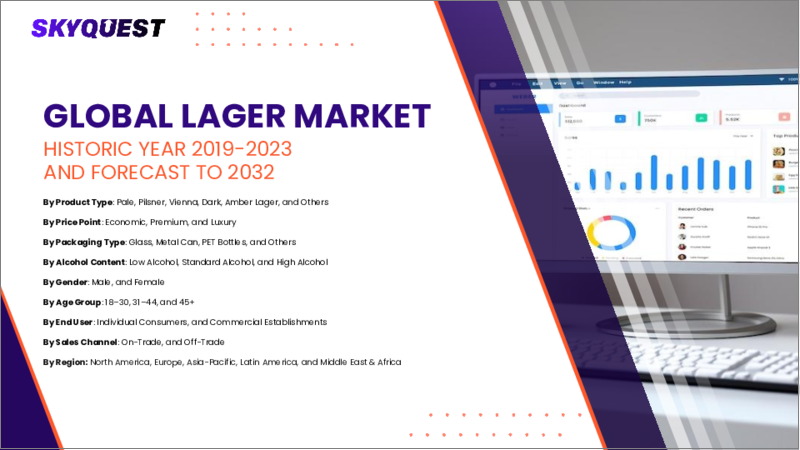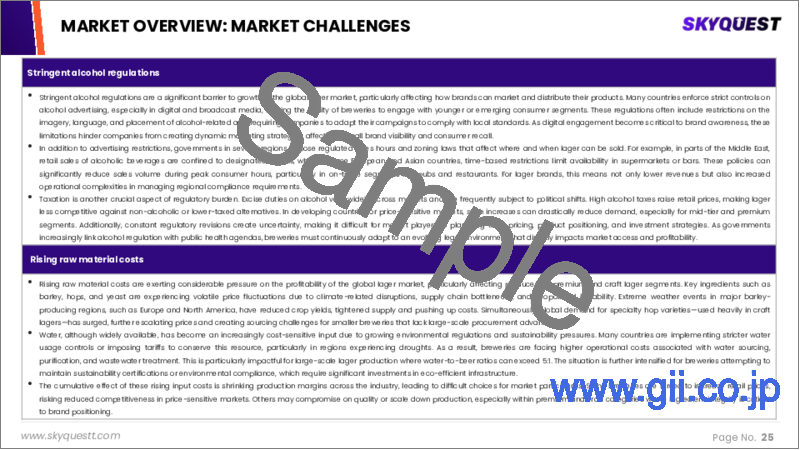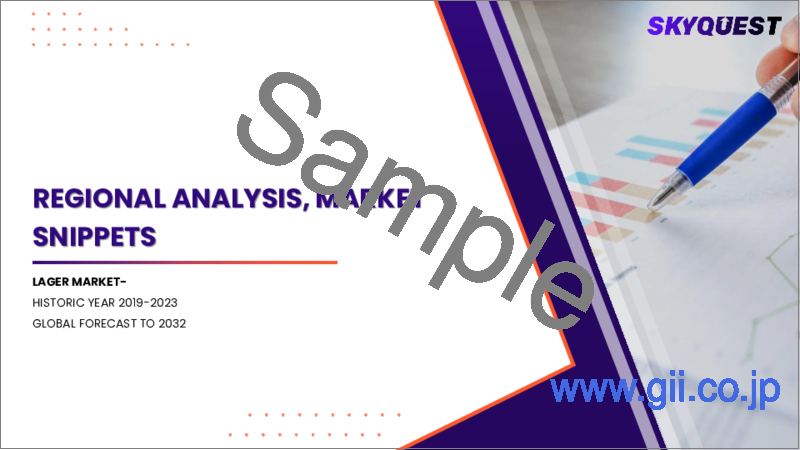|
|
市場調査レポート
商品コード
1722391
ラガーの市場規模、シェア、成長分析:タイプ別、パッケージ別、価格別、流通チャネル別、地域別 - 産業予測 2025~2032年Lager Market Size, Share, and Growth Analysis, By Type (Pale Lager, Dark Lager), By Packaging (Cans, Bottles), By Price Point, By Distribution Channel, By Region - Industry Forecast 2025-2032 |
||||||
|
|||||||
| ラガーの市場規模、シェア、成長分析:タイプ別、パッケージ別、価格別、流通チャネル別、地域別 - 産業予測 2025~2032年 |
|
出版日: 2025年05月05日
発行: SkyQuest
ページ情報: 英文 196 Pages
納期: 3~5営業日
|
- 全表示
- 概要
- 目次
ラガーの世界市場規模は、2023年に3,602億米ドルと評価され、2024年の3,692億米ドルから2032年には4,498億4,000万米ドルに成長し、予測期間(2025~2032年)のCAGRは2.5%で成長する見通しです。
世界のラガー市場は、オンラインとeコマース・チャネルの急増、ソーシャルメディアの影響力の増幅、ビール観光の人気上昇に後押しされ、大幅な成長を遂げています。消費者は、軽くて爽やかなビールを好むようになっており、ラガーは、カジュアルな飲酒者から愛好家まで、多様な層から好まれる選択肢となっています。特に若い消費者の間で社交的な飲酒の傾向が強まっており、ラガーの売上を大きく押し上げています。一方、大量生産ビールに代わる高品質のビールを求める消費者の間で、クラフトビールやプレミアムビールへの需要が高まっています。革新的なビール会社は、ユニークなフレーバーや持続可能な手法を導入し、環境意識の高い購買層を惹きつけています。特に、SweetWaterラガーの発売は、低カロリーでアルコールフリーの選択肢が好まれる健康動向に合わせて、消費者への直接販売チャネルを強化し、品質と入手しやすさへの継続的なコミットメントを示しています。
目次
イントロダクション
- 調査の目的
- 調査範囲
- 定義
調査手法
- 情報調達
- 二次と一次データの方法
- 市場規模予測
- 市場の前提条件と制限
エグゼクティブサマリー
- 世界市場の見通し
- 供給と需要の動向分析
- セグメント別機会分析
市場力学と見通し
- 市場概要
- 市場規模
- 市場力学
- 促進要因と機会
- 抑制要因と課題
- ポーターの分析
主な市場の考察
- 重要成功要因
- 競合の程度
- 主な投資機会
- 市場エコシステム
- 市場の魅力指数(2024年)
- PESTEL分析
- マクロ経済指標
- バリューチェーン分析
- 価格分析
- 顧客と購買基準の分析
ラガー市場規模:タイプ別
- 市場概要
- ペールラガー
- ダークラガー
- アンバーラガー
- その他
ラガー市場規模:パッケージ別
- 市場概要
- 缶
- ボトル
- その他
ラガー市場規模:価格別
- 市場概要
- スタンダードラガー
- プレミアムラガー
ラガー市場規模:流通チャネル別
- 市場概要
- スーパーマーケット
- コンビニエンスストア
- オンライン小売
- バーとレストラン
ラガー市場規模
- 北米
- 米国
- カナダ
- 欧州
- ドイツ
- スペイン
- フランス
- 英国
- イタリア
- その他欧州地域
- アジア太平洋地域
- 中国
- インド
- 日本
- 韓国
- その他アジア太平洋地域
- ラテンアメリカ
- ブラジル
- その他ラテンアメリカ地域
- 中東・アフリカ
- GCC諸国
- 南アフリカ
- その他中東・アフリカ
競合情報
- 上位5社の比較
- 主要企業の市場ポジショニング(2024年)
- 主な市場企業が採用した戦略
- 最近の市場動向
- 企業の市場シェア分析(2024年)
- 主要企業の企業プロファイル
- 企業の詳細
- 製品ポートフォリオ分析
- 企業のセグメント別シェア分析
- 収益の前年比比較(2022~2024年)
主要企業プロファイル
- Selkirk(Canada)
- Douglas Lager(Canada)
- Travis(Canada)
- Anheuser-Busch Companies LLC(US)
- Asahi Breweries Ltd.(Japan)
- Carlsberg Breweries A/S(Denmark)
- China Resources Beer(Holdings)Company Limited(China)
- Heineken N.V.(Netherlands)
- Kirin Brewery Company Limited(Japan)
- Molson Coors Beverage Company(US)
- Tsingtao Brewery Company Limited(China)
- United Breweries Holdings Limited(India)
結論と提言
Global Lager Market size was valued at USD 360.2 billion in 2023 and is poised to grow from USD 369.2 billion in 2024 to USD 449.84 billion by 2032, growing at a CAGR of 2.5% during the forecast period (2025-2032).
The global lager market is experiencing substantial growth, propelled by the surge in online and e-commerce channels, amplified social media influence, and rising popularity of beer tourism. Consumers are increasingly favoring light and refreshing beers, which has positioned lager as a preferred choice among diverse demographics, from casual drinkers to aficionados. The growing trend of social drinking, particularly among younger consumers, has significantly boosted lager sales. Meanwhile, the demand for craft and premium options is rising, as consumers seek quality alternatives to mass-produced beers. Innovative breweries are introducing unique flavors and sustainable practices to attract eco-conscious buyers. Notably, the launch of SweetWater Lager demonstrates the ongoing commitment to quality and accessibility through enhanced direct-to-consumer sales channels, aligning with health trends that favor low-calorie and alcohol-free options.
Top-down and bottom-up approaches were used to estimate and validate the size of the Global Lager market and to estimate the size of various other dependent submarkets. The research methodology used to estimate the market size includes the following details: The key players in the market were identified through secondary research, and their market shares in the respective regions were determined through primary and secondary research. This entire procedure includes the study of the annual and financial reports of the top market players and extensive interviews for key insights from industry leaders such as CEOs, VPs, directors, and marketing executives. All percentage shares split, and breakdowns were determined using secondary sources and verified through Primary sources. All possible parameters that affect the markets covered in this research study have been accounted for, viewed in extensive detail, verified through primary research, and analyzed to get the final quantitative and qualitative data.
Global Lager Market Segments Analysis
Global Lager Market is segmented by Type, Packaging, Price Point, Distribution Channel and region. Based on Type, the market is segmented into Pale Lager, Dark Lager, Amber Lager and Others. Based on Packaging, the market is segmented into Cans, Bottles and Others. Based on Price Point, the market is segmented into Standard Lager and Premium Lager. Based on Distribution Channel, the market is segmented into Supermarkets, Convenience Stores, Online Retail and Bars and Restaurants. Based on region, the market is segmented into North America, Europe, Asia Pacific, Latin America and Middle East & Africa.
Driver of the Global Lager Market
The growth of the global lager market is significantly driven by the expansion of e-commerce and online shopping platforms. Industry forecasts project that global B2C e-commerce sales will soar to USD 5.5 trillion by 2027, achieving a consistent compound annual growth rate of 14.4%. Contributing factors include increased digitization, wider internet accessibility, and rising disposable incomes, which empower consumers to explore and purchase a variety of products easily. Moreover, online platforms provide convenient access to an extensive array of brands from diverse regions and breweries, overcoming geographical barriers and further propelling market growth, with social media influence playing a substantial role.
Restraints in the Global Lager Market
The global lager market faces significant challenges due to stringent government regulations surrounding the production, sale, and marketing of alcoholic beverages. Many countries have imposed high excise taxes, strict licensing requirements, and advertising restrictions, which pose serious obstacles for the lager industry. For instance, in regions such as Europe and North America, the increase in beer taxation leads to higher costs for both production and consumption, consequently affecting overall sales figures. These regulatory barriers hinder the growth and competitive capabilities of breweries, making it difficult for them to expand their operations and gain a foothold in the global market.
Market Trends of the Global Lager Market
The global lager market is experiencing a notable shift towards low-alcohol and alcohol-free options, driven by the rising health consciousness among consumers. This trend is particularly prominent among millennials, who prioritize moderation without compromising on taste. As breweries expand their product offerings to include a variety of alcohol-free lagers, brands like Heineken 0.0 and Budweiser Zero are witnessing significant sales growth. Additionally, supportive anti-excessive drinking legislation further reinforces this trend, marking a transformative period in the lager sector where health-focused choices are becoming the norm, reshaping consumer preferences and driving innovation within the market.
Table of Contents
Introduction
- Objectives of the Study
- Scope of the Report
- Definitions
Research Methodology
- Information Procurement
- Secondary & Primary Data Methods
- Market Size Estimation
- Market Assumptions & Limitations
Executive Summary
- Global Market Outlook
- Supply & Demand Trend Analysis
- Segmental Opportunity Analysis
Market Dynamics & Outlook
- Market Overview
- Market Size
- Market Dynamics
- Drivers & Opportunities
- Restraints & Challenges
- Porters Analysis
- Competitive rivalry
- Threat of substitute
- Bargaining power of buyers
- Threat of new entrants
- Bargaining power of suppliers
Key Market Insights
- Key Success Factors
- Degree of Competition
- Top Investment Pockets
- Market Ecosystem
- Market Attractiveness Index, 2024
- PESTEL Analysis
- Macro-Economic Indicators
- Value Chain Analysis
- Pricing Analysis
- Customer And Buying Criteria Analysis
Global Lager Market Size by Type & CAGR (2025-2032)
- Market Overview
- Pale Lager
- Dark Lager
- Amber Lager
- Others
Global Lager Market Size by Packaging & CAGR (2025-2032)
- Market Overview
- Cans
- Bottles
- Others
Global Lager Market Size by Price Point & CAGR (2025-2032)
- Market Overview
- Standard Lager
- Premium Lager
Global Lager Market Size by Distribution Channel & CAGR (2025-2032)
- Market Overview
- Supermarkets
- Convenience Stores
- Online Retail
- Bars and Restaurants
Global Lager Market Size & CAGR (2025-2032)
- North America (Type, Packaging, Price Point, Distribution Channel)
- US
- Canada
- Europe (Type, Packaging, Price Point, Distribution Channel)
- Germany
- Spain
- France
- UK
- Italy
- Rest of Europe
- Asia Pacific (Type, Packaging, Price Point, Distribution Channel)
- China
- India
- Japan
- South Korea
- Rest of Asia-Pacific
- Latin America (Type, Packaging, Price Point, Distribution Channel)
- Brazil
- Rest of Latin America
- Middle East & Africa (Type, Packaging, Price Point, Distribution Channel)
- GCC Countries
- South Africa
- Rest of Middle East & Africa
Competitive Intelligence
- Top 5 Player Comparison
- Market Positioning of Key Players, 2024
- Strategies Adopted by Key Market Players
- Recent Developments in the Market
- Company Market Share Analysis, 2024
- Company Profiles of All Key Players
- Company Details
- Product Portfolio Analysis
- Company's Segmental Share Analysis
- Revenue Y-O-Y Comparison (2022-2024)
Key Company Profiles
- Selkirk (Canada)
- Company Overview
- Business Segment Overview
- Financial Updates
- Key Developments
- Douglas Lager (Canada)
- Company Overview
- Business Segment Overview
- Financial Updates
- Key Developments
- Travis (Canada)
- Company Overview
- Business Segment Overview
- Financial Updates
- Key Developments
- Anheuser-Busch Companies LLC (US)
- Company Overview
- Business Segment Overview
- Financial Updates
- Key Developments
- Asahi Breweries Ltd. (Japan)
- Company Overview
- Business Segment Overview
- Financial Updates
- Key Developments
- Carlsberg Breweries A/S (Denmark)
- Company Overview
- Business Segment Overview
- Financial Updates
- Key Developments
- China Resources Beer (Holdings) Company Limited (China)
- Company Overview
- Business Segment Overview
- Financial Updates
- Key Developments
- Heineken N.V. (Netherlands)
- Company Overview
- Business Segment Overview
- Financial Updates
- Key Developments
- Kirin Brewery Company Limited (Japan)
- Company Overview
- Business Segment Overview
- Financial Updates
- Key Developments
- Molson Coors Beverage Company (US)
- Company Overview
- Business Segment Overview
- Financial Updates
- Key Developments
- Tsingtao Brewery Company Limited (China)
- Company Overview
- Business Segment Overview
- Financial Updates
- Key Developments
- United Breweries Holdings Limited (India)
- Company Overview
- Business Segment Overview
- Financial Updates
- Key Developments






